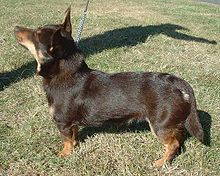Lancashire Heeler

Lancashire Heeler at a dog show.
|
|||||||||||||||||||||
| Other names | Ormskirk Heeler Ormskirk Terrier |
||||||||||||||||||||
|---|---|---|---|---|---|---|---|---|---|---|---|---|---|---|---|---|---|---|---|---|---|
| Origin | England | ||||||||||||||||||||
|
|||||||||||||||||||||
| Domestic dog (''Canis lupus familiaris) | |||||||||||||||||||||
| Classification / standards | |||
|---|---|---|---|
| FCI | Group 1, Section 1 Sheepdogs #360 (provisional) | standard | |
| AKC | |||
| The AKC Foundation Stock Service (FSS) is an optional recording service for purebred dogs that are not yet eligible for AKC registration. | |||
| KC (UK) | Pastorial | standard | |
| UKC | Herding | standard | |
The Lancashire Heeler is a small breed of dog developed for use as a drover and herder of cattle. The Lancashire Heeler is listed by the Kennel Club (UK) as a vulnerable breed.
The coat is harsh and smooth with an undercoat which keeps the dog dry in all weathers. It may have a slight mane round the neck in winter. The dog is usually black and tan, but liver and tan is now recognised by the Kennel Club. They are slightly longer than height at withers, usually measures between 10–12 inches (25–30 cm) at the shoulder and weighs 13–18 pounds (5.9–8.2 kg). Ears can be tipped or erect.
It is alert, friendly, energetic, intelligent, playful and a pleasant companion. Personality can range from lazy and playful to energetic and talkative. It is actually a very strong dog that likes to participate in all kinds of activities, and can carry a ball or object the size of itself. The Lancashire Heeler is friendly towards its owners and passers-by on the street but may be aggressive towards an unknown character on their territory.
The Lancashire Heeler has a life expectancy of 12–15 years or more. The three most common serious conditions that can affect Heelers are Collie eye anomaly, Primary lens luxation and Persistent pupillary membranes. As well as these eye conditions, dogs of this breed may suffer from Patella luxation.
Precise details of the origin of breed are unknown. However, it is accepted that a type of Welsh Corgi was used to drive livestock to the north west of England from Wales. In the Ormskirk area, a type of black and tan terrier called the Manchester Terrier was introduced which resulted in what is now known as the Lancashire Heeler. The breed has been known in its home county for over a hundred and fifty years as a general purpose farm dog, capable of both ratting and herding cattle.
...
Wikipedia
